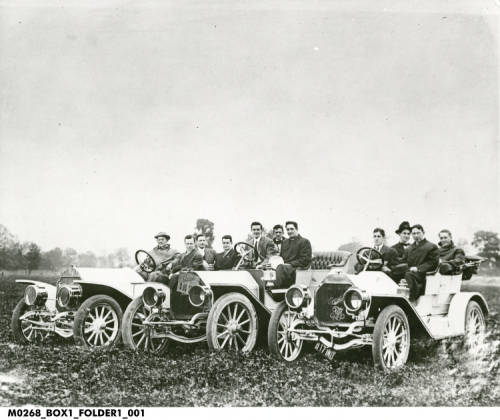
Purchase Tickets
Balloons Over Indianapolis
January 14, 2021

On a balmy June weekend in 1909, thousands of Indianapolis residents piled into their cars for what would be in the years to come a familiar trip to a track on the city’s west side — the Indianapolis Motor Speedway. The crowd had gathered, however, not to witness men racing automobiles around the two-and-a-half-mile oval, but to marvel at the daredevil antics of aeronauts willing to risk their lives in a national hot-air balloon race.

As a means of extra revenue, motorcycle races and other special events were held at the facility before the race track was completed. On June 5, 1909, the National Balloon Race was held at the Speedway. Although there were 3,500 paying customers, more than 40,000 spectators watched for free outside the grounds, creating a tremendous traffic jam. Indiana Historical Society
The promotional wizard behind the event was no stranger to attracting attention to himself. Born in Greensburg, Indiana, Carl Fisher had quit school at a young age in order to support his family. Over the years, he had worked at a number of professions, including clerking in a bookstore and hawking newspapers, candy, and other products on trains leaving Indianapolis. In 1891 he and his two brothers opened a bicycle shop in Indianapolis, where they repaired flat tires for just twenty-five cents. When the automotive craze swept the country, Fisher jumped on the bandwagon, converting his bicycle shop into an automobile repair/sales facility and barnstorming through the Midwest with his friends putting on automotive races.
To promote his new product, Fisher staged a series of crazy stunts sure to earn him plenty of attention in Indianapolis newspapers. On one occasion, while his brothers waited on the street below, he shoved a seven-passenger car off a building’s roof. When the car safely reached the street, one of Fisher’s brothers climbed into the car, started it up, and drove away with the crowd’s cheers ringing in his ears.

Carl G. Fisher (far left), president of the Indianapolis Motor Speedway, is pictured taking the editorial staff of the Indianapolis Star on a tour of the grounds that would soon become the speedway. This was nearly a month before the balloon race that took off from the site. Indiana Historical Society
On a 1905 trip overseas to compete in the Gordon Bennett Cup Series in France, Fisher was stunned by the European cars’ superiority over the American models. To help improve the automotive industry back home, he conceived of a proving ground where cars could be tested and raced. In 1909 Fisher, Arthur Newby, Frank Wheeler, and James Allison put together $25,000 in capital to form the Indianapolis Motor Speedway Company and transformed the Pressley Farm into one of the country’s premier auto racing tracks.
Before cars took to the track, however, Fisher had the idea of christening the facility by sponsoring a national championship balloon race on June 5, 1909. This was not the first time Fisher had used balloons for publicizing one of his ventures. Just the year before, with his friend, George Bumbaugh of Springfield, Illinois, Fisher had inflated a large balloon and attached to it a Stoddard-Dayton automobile. Indianapolis residents were astonished to look up on the late afternoon of October 30, 1908, to see an automobile sailing through the sky with Fisher waving at them from the driver’s seat.
Sanctioned by the Aero Club of America, the Indianapolis balloon competition featured nine balloons entered in two categories. Three were featured in the handicap race for balloons with capacities of forty thousand cubic feet—the Ohio, the Indianapolis (piloted by Indianapolis physician Goethe Link and his friend J. R. “Russy” Irwin), and the Chicago. Entered in the national contest for balloon with capacities of eighty thousand cubic feet were the New York, Indiana (manned by Fisher and Bumbaugh), Saint Louis III, Cleveland, Hoosier, and University City. In order to fill the craft to the proper size, Fisher had a special gas main run from the main Indianapolis gas plant near Northwestern Avenue and Fall Creek to the Speedway location.

A balloon race was held in June of 1909 to generate revenue and interest in the automobile races at the Speedway. Seen here are some of the 3,500 paying customers. Outside the track there was a huge traffic jam and 40,000 spectators who watched for free. Spectators are looking to the right as one of the balloons has been launched and has floated away.
Indiana Historical Society.
On Saturday afternoon, June 5, the balloons rose into the air as more than forty thousand fans cheered. The crush of spectators was so great that Indiana governor Thomas Marshall could not reach the location in time to serve as the contest’s official starter. As Fisher’s craft floated over the grandstand, where spectators had paid $1 each for their seats, he threw a number of American beauty roses to the crowd that had been sent to him by his mother. Asked for his opinion about the event as the last balloon had left the ground for parts unknown, Charles J. Glidden, noted industrialist and one of the chief founders of the Aero Club, called it “without doubt the most beautiful and the best conducted that human eyes have ever witnessed.”
Those entered in the race were seeking to remain in the air the longest and to travel the farthest distance. As day turned to night, Link remembered riding over a forest in southern Indiana, skimming over the treetops and dragging from the balloon a three-hundred-foot-long drag rope that slammed into a house and made a noise that could be heard for miles. “I wondered what those people thought it was,” said Link. As the aeronauts left Indiana for the states of Kentucky and Tennessee, they began to come under fire from frightened farmers armed with shotguns and rifles. The gunfire caused Link and Irwin to ascend to a height of almost three miles. Gasping for breath due to the thin supply of oxygen and shivering from the cold even while wrapped in an overcoat and blanket, Irwin noted: “If I ever get out of this alive, I’ll never do this again.”
The two men survived their ordeal and finally landed at 11:15 a.m. Sunday near Westmoreland, Tennessee. In winning the handicap race, for which they received an engraved silver cup, the duo had been in the air for approximately nineteen hours and had traveled two hundred and fifty miles. Before landing, Link had to lighten the balloon’s load by throwing out a full lunch basket. Some of the local residents volunteered to retrieve the lost lunch for the hungry aeronauts, but when the basket was returned to them they discovered that ants had invaded their provisions. Link and Irwin returned to Indianapolis the next day after a breakfast of hard-boiled eggs.
The national contest ended in controversy. Fisher and Bumbaugh in the Indiana had remained in the air for forty-eight hours and thirty minutes, finally landing near Tennessee City, Tennessee, approximately fifty miles from Nashville, on Monday evening. As had Link and Irwin, Fisher and Bumbaugh had become targets for trigger-happy people on the ground. “They began firing on us when we were in Brown County, Indiana, and have kept up the target practice ever since—right up to six o’clock Monday evening, when we stepped out of the basket,” Fisher said in a telephone interview with an Indianapolis Star reporter. The gunfire increased in volume as the balloon made its way to Tennessee. “No more ballooning in Tennessee for me,” Fisher vowed.
The controversy occurred when Fisher and Bumbaugh had brought their balloon in for a landing on a pile of railroad cross ties four feet off the ground in order to take on a supply of water. Fisher argued that because the balloon had never touched ground, and he and Bumbaugh had remained in the basket, they were within the rules of the contest. Other contestants, and Aero Club officials, disagreed with Fisher’s reasoning. Nevertheless, the duo was treated as heroes when they returned to Indianapolis on an interurban car from Louisville. A crowd of more than two hundred people greeted the aeronauts, who were treated to a parade complete with band and fireworks before a banquet in their honor at the Denison Hotel. The crowd serenaded the men with the following chant: “Fisher and Bumbaugh, they’re the stuff, / Fisher and Bumbaugh, they’re no bluff. / Sure they came down before they oughter, / But only to get a bucket of water.”









